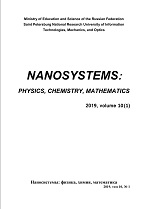|
CHEMISTRY AND MATERIAL SCIENCE
Influence of high energy milling on titanium oxide Ti$_3$O$_5$ crystal structure
Albina A. Valeevaa, Irina B. Doroshevabc, Anna A. Sushnikovac
a Institute of Solid State Chemistry, Ural Branch of the Russian Academy of Sciences, 620108, Ekaterinburg, Russia
b Ural Federal University, 620002, Ekaterinburg, Russia
c Institute of Metallurgy, Ural Branch of the Russian Academy of Sciences, 620016 Ekaterinburg, Russia
Abstract:
The titanium oxide (Ti$_3$O$_5$) microcrystals were synthesized by using solid-phase sintering from a mixture of titanium Ti and titanium dioxide TiO2 powders. Subsequently, Ti$_3$O$_5$ nanocrystals were produced by using high-energy ball milling for 15–480 minutes. A full-profile analysis of the X-ray diffraction spectra of milled Ti$_3$O$_5$ powders showed that high-energy milling does not lead to disordering or changing of the structure and stoichiometry, the structure remains monoclinic (sp. gr. $C2/m$), and XRD reflections are broadened due to the small particle size and microdeformations. Experimental data show that increasing of the milling time leads to decreasing of the coherent scattering regions up to 26 nm, increasing of the powder volume fraction of the nanophase up to 81%, and increasing of microdeformations value. The morphology and the surface area of milled nanopowders were examined by SEM, HRTEM and BET techniques.
Keywords:
high-energy ball milling, Ti$_3$O$_5$, XRD, BET, SEM, HRTEM.
Received: 05.10.2022
Accepted: 24.10.2022
Citation:
Albina A. Valeeva, Irina B. Dorosheva, Anna A. Sushnikova, “Influence of high energy milling on titanium oxide Ti$_3$O$_5$ crystal structure”, Nanosystems: Physics, Chemistry, Mathematics, 14:1 (2023), 107–111
Linking options:
https://www.mathnet.ru/eng/nano1168 https://www.mathnet.ru/eng/nano/v14/i1/p107
|

| Statistics & downloads: |
| Abstract page: | 34 | | Full-text PDF : | 11 |
|




 Contact us:
Contact us: Terms of Use
Terms of Use
 Registration to the website
Registration to the website Logotypes
Logotypes








 Citation in format
Citation in format 